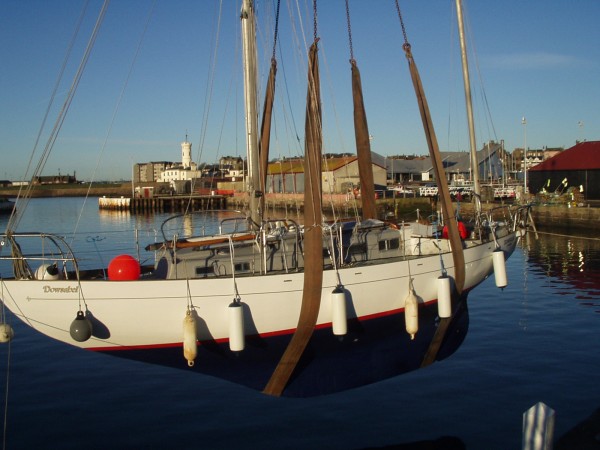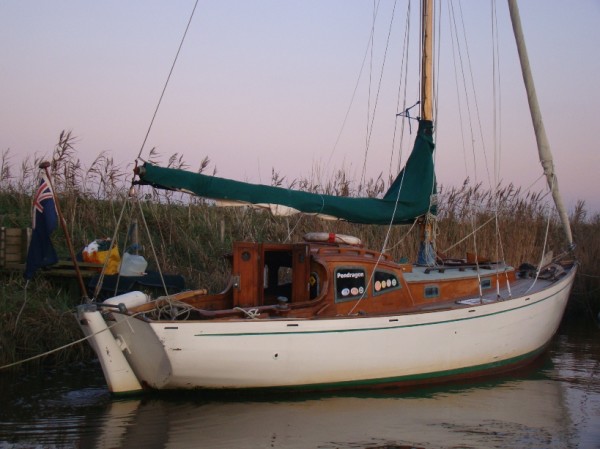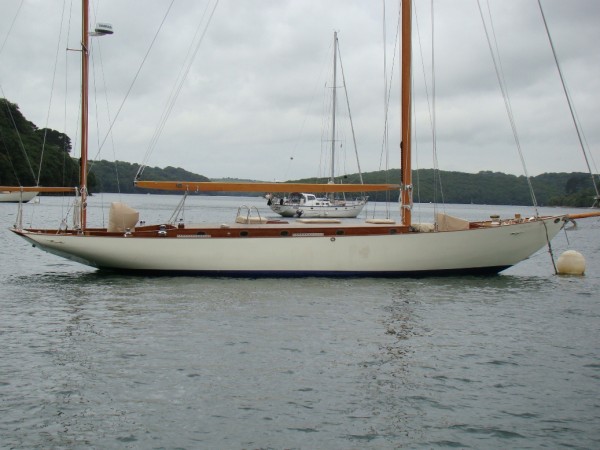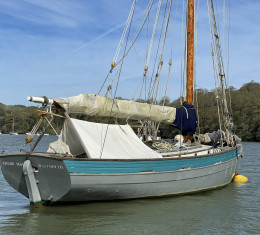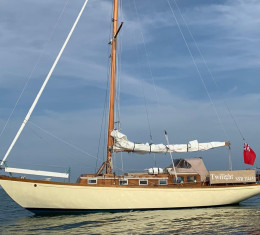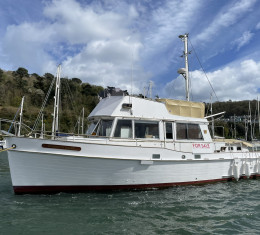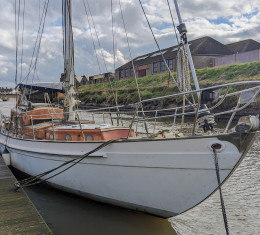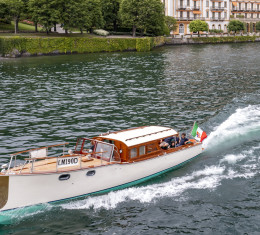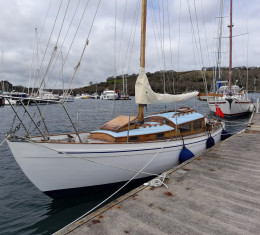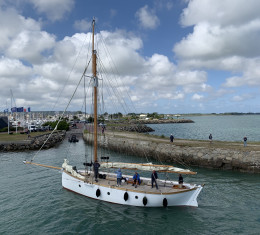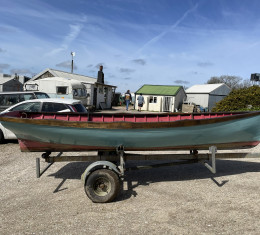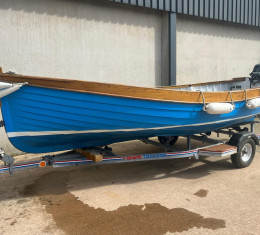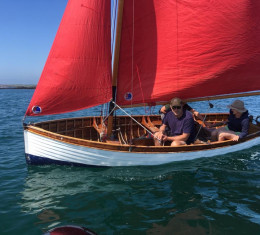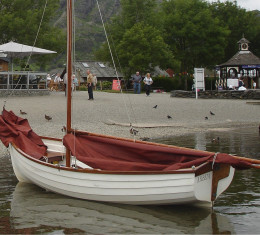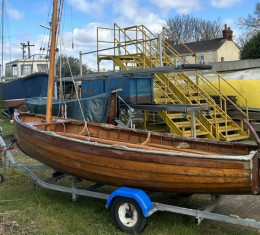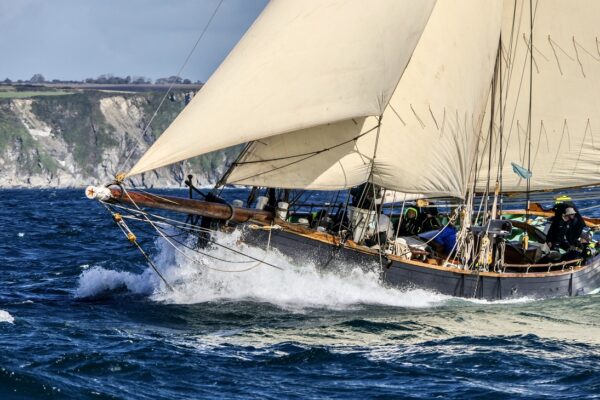Wooden ships comments on this Dickie’s of Tarbet sloop
Designed and built by Dickies of Tarbert, Loch Fyne in 1939.
This is a classic little sloop in the truest sense of the words, very typical of Dickies work in both design and build. She is not a big boat by modern standard but unlike so many modern yacht designs, she is a very pretty yacht, she has a sweet sheer line and is a dry and easily driven yacht with a turn of speed which will surprise many modern yachts.
In 1971 she won the John Illingworth Trophy passage race through the Pentland Firth round the north of Scotland and has visited Norway several times from her base for many years at Crinan and Fort William on Scotland’s west coast.
In present 18 year ownership she has been consistently up-graded and improved and we have survey reports and receipts over the period to confirm the work done. JANUARY 2017 SURVEY AVAILABLE.
If the owner was fitter there would be no question of selling her so someone is going to get a fine yacht which always attracts attention wherever she goes.
The design is typical of her period with a sweeping stemline from stemhead down to the ballast keel in a fair curve, a fairly steep rise to the floors, and a very sweet sheer with a gentle lift to the short counter stern.
There are some references to the yacht being an Alfred Mylne design and the Mylne Archive have a note of her name but no drawings although there are several Mylne designs which are remarkably similar to this yacht. There is no doubt that there was considerable contact between the Dickies and Alfred Mylne and of course one Dickie brother Peter actually did his drawing apprenticeship with the other great name in the area, Wm Fife.
Planked in 7/8” Columbian pine or similar, all fastened with copper nails, clenched in the Scottish fashion, to steamed oak timbers, 1 ¼” x 7/8” at approx 10” centres.
This is a very fair hull, painted white with a thin blue cove line.
Long external iron ballast keel. Mild steel galvanised keel bolts reported renewed in 1991/2 one removed in July 04, found with minimal wastage replaced, bolts checked again in 2007.
Galvanised strap floors. 2003 survey recommends simply wire brushing a painting.
All sea-cocks removed for checking and one replaced in 2004 refit.
The deck has been upgraded. The original canvas-sheathed pine deck has been stripped of the canvas, faired and overlaid with ply, epoxy/glass sheathed and painted.
New varnished teak toe rails and rubbing strakes with carved cove line below, picked out in blue.
The deck is particularly clear and uncluttered with generous side decks.
Low level varnished teak fore hatch on the deck in front of the mast and a hatch on the aft deck abaft the rudder stock fitted with sealed, drop-in ply box gas bottle locker with one bottle, both with smart covers.
Stainless steel pulpit, push-pit and stanchions all round with twin guard wires.
Wooden cleat on the aft deck to take aft lines. Sampson post on the fore deck.
Substantial period manual windlass on the fore deck take forward lines, bronze fair leads forward and aft.
Twin chain roller galvanised stemhead fitting.
The coach-roof extends forward as far as the mast with varnished teak coamings fitted with 3 bronze port holes each side.
The coach-roof deck was refitted in 2008 by Nick Gates & Co – the original canvas removed, the pine boards faired, 6mm ply fitted, epoxy glass sheathed and painted.
Varnished teak margin boards give a most attractive effect.
Varnished grab rails each side.
Varnished teak sliding hatch and twin doors to the cabin entrance, slightly off-set to stbd..
Bronze port and stbd nav lights on the coamings.
Deep cock-pit sheltered by the coach-roof with varnished teak coamings.
Varnished mahogany seat lockers each side and wide bridge deck across forward.
Teak grating in the well with timber access hatch to the shaft gland below.
The well is grp sheathed and self draining.
Tiller steering with varnished tiller on bronze fittings. Nice varnished mahogany collar round the stock aperture.
Bermudian sloop rig on gold anodised, oval-section aluminium mast stepped through the deck onto the keel.
External mainsail track.
Spinnaker track on the fwd face.
Single spreaders.
Round section aluminium boom with external track and roller reefing gear, mounted on a track on the aft face of the mast.
The boom has been converted to slab reefing with a track to take the leach pennants, lead eyes and jamming cleats at the mast end. Stainless steel rams horns.
The boom sheets to a single eye bolt abaft the after cock-pit coamings, single tailed with single sheaved tufnol blocks, jammer on the roller block. Cleat either side on the outside face of the coamings to take the tail.
Rigging. All stainless steel replaced in Feb 2004.
Twin lowers and cap shrouds.
Single standing back-stay to the counter arch-board.
Single masthead/stemhead fore stay incorporating Furlex roller furling gear.
New internal galvanised steel chain plates with new bolts.
Winches.
Pair of bottom action bronze Gibb halyard winches.
Single Lewmar mast winch to port takes the kicking strap.
Pair of top-action Lewmar cock-pit sheet winches on the coamings.
Adjacent cleat on the outside face of the coamings to take the tails.
Track with single cars each side on the side decks.
Sails.
Mainsail and genoa on the Furlex roller gear. Both sails have only 12 months usage and are Beneteau sails, recut for the yacht and fitted 2011.
Engine.
Yanmar 3GM 27hp 3-cyl diesel fitted 1991.
Single lever Morse controls to centre-line 3-blade prop gives a maximum speed of 6knts.
1 litre per hour consumption at 1800rpm.
Stainless steel 50 litre fuel tank under the stbd cock-pit locker.
2 x 12v batteries under port side cock-pit lockers on 12v circuits.
Engine driven alternator + solar panel.
Accommodation.
4 berths.
V-berths in the fore cabin, fore hatch over. Chain locker right forward with T&G pine bulkhead fitted with door.
Varnished deck beams above.
T&G pine bulkhead just forward of the mast with port side opening.
Saloon cabin with port and stbd settee berths, shelves above. Table on alloy cantilever arm swing away to clear the through passage.
Galley in the after stbd corner.
Smart stainless steel gas cooker, gimballed + fiddles. 2-burners grill and ove.
Stainless steel tray inset in a shelf which fits over the cooker doubles as a draining board.
Twin stainless steel sinks against the bulkhead with hand pump, sink drains overboard.
Heads compartment in the after port corner. Sea toilet.
Pull-out shelf against the bulkhead forms the chart desk, electrical panel and nav instruments above.
Manual bilge pump and fire extinguisher below.
Engine box step up to the cock-pit.
Varnished mahogany coamings and joinery.
6’+ head-room in the cabin.
Equipment.
Bulkhead compass to stbd.
Sounder
Log
ST depth/speed/wind on the port side cock-pit bulkhead.
Auto-pilot
Wind vane self steering
GPS
Standard Horizon 7”chart plotter.
VHF DSC radio
2 life buoys
Coastal flare pack – 2012
2 fire extinguishers.
45kg plough anchor
35kg fisherman anchor
Manual windlass
Approx 200’ chain
Approx 180’ warp and short chain on the fisherman
Warps and fenders.
All over boat cover suspended from the boom, from mast back over the cock-pit.
This is a classic little sloop in the truest sense of the words, very typical of Dickies work in both design and build. She is not a big boat by modern standard but unlike so many modern yacht designs, she is a very pretty yacht, she has a sweet sheer line and is a dry and easily driven yacht with a turn of speed which will surprise many modern yachts.
In 1971 she won the John Illingworth Trophy passage race through the Pentland Firth round the north of Scotland and has visited Norway several times from her base for many years at Crinan and Fort William on Scotland’s west coast.
In present 18 year ownership she has been consistently up-graded and improved and we have survey reports and receipts over the period to confirm the work done.
If the owner was fitter there would be no question of selling her so someone is going to get a fine yacht which always attracts attention wherever she goes.



